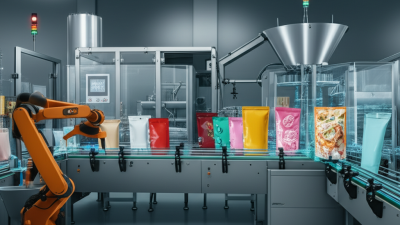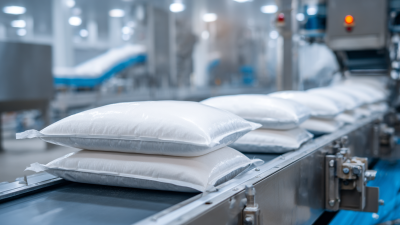- Phone:+86 15218629499
- Phone: +86 15766990063
- E-mail: Yzprinting01@163.com
In the modern era of food packaging, the need for efficiency and sustainability has never been more pressing. As consumers become increasingly aware of their environmental footprint, the food industry is challenged to innovate and adapt. One of the most transformative advancements in this realm is Pouch Packing, a packaging method that not only enhances product preservation but also significantly reduces waste. By utilizing flexible pouches instead of traditional rigid packaging, the food sector has discovered a pathway to decrease unnecessary materials—leading to an impressive reduction of 30% in waste generation.

This shift towards Pouch Packing encapsulates a broader movement towards sustainability, where companies are embracing eco-friendly practices while also meeting the demands of health-conscious consumers. The versatility of pouch designs allows for various product types, from snacks to beverages, fostering a more sustainable approach to packaging. As we delve deeper into the impacts and benefits of Pouch Packing, it becomes clear that this innovative solution is revolutionizing efficiency in the food packaging industry, creating a win-win scenario for both businesses and the environment.
Pouch packing has emerged as a sustainable alternative to traditional food packaging methods, offering numerous ecological advantages. By utilizing flexible pouches, manufacturers can significantly reduce the amount of material required to package products. Unlike rigid containers, pouches are lightweight and often use less plastic, thereby leading to a notable decrease in overall waste generated. This innovative approach not only conserves resources during production but also minimizes the environmental impact associated with disposal, as pouches are increasingly designed to be recyclable or compostable.
Moreover, pouch packing enhances efficiency throughout the supply chain. The streamlined design allows for more products to be shipped in a single load, reducing the carbon footprint linked to transportation. As consumers grow more environmentally conscious, the demand for sustainable packaging solutions increases, positioning pouch packing as a forward-thinking choice for companies looking to align with eco-friendly practices. This shift not only benefits the environment but also resonates with consumers who are increasingly seeking products that reflect their values and commitment to sustainability.
This chart illustrates the reduction in waste achieved through the adoption of pouch packing compared to traditional packaging methods. The data reflects industry-wide trends in food packaging waste reduction.
Pouch packing is rapidly transforming the food packaging landscape by offering significant advantages in waste reduction. By utilizing lightweight materials and innovative designs, pouch packaging can reduce food waste by as much as 30%. This is particularly beneficial in a world increasingly focused on sustainability, where minimizing waste is crucial for environmental preservation and resource management.
Smart technologies are revolutionizing pouch packing as they allow for enhanced functionality, such as freshness sensors that monitor product quality. This not only prolongs the shelf life of food items but also provides consumers with real-time information on the freshness of the contents, helping to prevent unnecessary waste. By adopting pouch packing solutions, food manufacturers can achieve greater efficiency while contributing to a circular economy through improved recycling and reuse practices.
Tip: When choosing pouch packaging, look for options that incorporate recycled materials to further minimize your environmental footprint. Investing in packs that feature smart technology can also ensure that you are consuming food at its peak freshness, thereby reducing waste at home.
Pouch packaging is significantly transforming the food industry by reducing costs and waste. According to a report by the Food and Agriculture Organization (FAO), over one-third of all food produced worldwide is wasted, costing about $1 trillion annually. By utilizing pouch packaging, food manufacturers can achieve up to 30% less waste compared to traditional packaging methods. This reduction is primarily due to the airtight seal that pouches provide, prolonging shelf life and minimizing spoilage.
In addition to minimizing waste, the cost savings associated with pouch packaging are compelling. A study by Smithers Pira indicates that flexible packaging, including pouches, can lead to a cost reduction of approximately 20% in logistics and storage costs. This is due to their lightweight nature and space-efficient design. The combination of reduced materials needed and lower shipping costs is reshaping the financial landscape for food producers, enabling them to allocate funds towards sustainable practices and innovation. The strategic shift towards pouch packaging not only addresses economic efficiency but also aligns with growing consumer demand for environmentally responsible products.
The role of advanced materials in enhancing pouch packing efficiency cannot be overstated. Recent industry reports indicate that innovative materials such as bio-based polymers and high-barrier films can significantly reduce packaging waste, contributing to a 30% decrease in overall food packaging waste. These materials not only extend shelf life but also reduce the need for excessive packaging layers. For instance, a study by Smithers Pira highlights that transitioning to lighter-weight materials can save millions of tons of waste globally while maintaining product freshness and safety.
One way to leverage these advanced materials is to adopt packaging solutions designed for optimized resource use. Tips to consider include selecting materials with better recyclability and sourcing options that utilize renewable resources. Additionally, implementing designs that minimize air and moisture exposure can further enhance product longevity while reducing waste. When companies prioritize sustainable materials, they ideally meet consumer demand for eco-friendly options, ultimately benefiting both the environment and their bottom line.
Furthermore, utilizing cutting-edge technology such as nanotechnology in pouch packing can lead to higher performance materials that are not only lighter but also stronger. This ensures that products maintain their integrity during transport and storage, thus reducing spoilage and waste. By embracing these advancements, businesses can significantly improve their sustainability profile and operational efficiency.
| Dimension | Value |
|---|---|
| Type of Pouch Material | Recyclable Plastic |
| Weight Reduction | 20% less weight compared to rigid packaging |
| Waste Reduction | 30% less waste generated |
| Shelf Life Extension | Up to 3 times longer than traditional packaging |
| Recycling Rate of Materials | Over 60% recyclable |
| Consumer Preference | 70% prefer pouches over rigid containers |
| Cost Savings | Reduces packaging costs by approximately 15% |
The introduction of pouch packing solutions has proven to be a game-changer in the food packaging industry, significantly reducing waste while enhancing efficiency. Major brands have successfully implemented these sustainable packaging techniques, demonstrating tangible benefits through various case studies. These pouch packing systems utilize innovative designs that optimize material usage, resulting in a striking 30% reduction in packaging waste compared to traditional methods. By examining the strategies adopted by leading companies, we can identify best practices that promote sustainability while meeting consumer demands.
In addition to pouch packing, the food and beverage industry is witnessing a resurgence of interest in reusable packaging. This shift underscores a growing recognition of the need for sustainable solutions that minimize environmental impact. While the complexity of implementing reusable systems poses challenges, successful case studies from industry leaders highlight the potential for significant waste reduction. By aligning innovative packaging strategies with sustainability goals, brands not only contribute to a greener future but also resonate with increasingly eco-conscious consumers, paving the way for a more responsible approach to food packaging.






